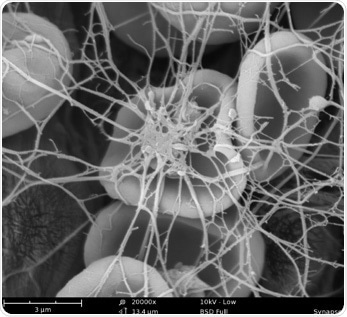Blood is a vital component of the body. It supplies the required oxygen to all organs and tissues and eliminates undesirable metabolites from cells. Besides transporting oxygen, blood also protects the body from various diseases with the help of the immune cells and platelets present in it. These blood cells also have an important role in bleeding disorders.
Scientists throughout the world are interested in comprehending the nature of blood cell interactions, such as binding to different fibers and clotting, specifically. This article describes the effective role that integrated scanning electron microscopes (SEMs) and correlative light-electron microscopy (CLEM) can play, in laboratories involved in blood research.

Figure 1. Each wounding causes a reaction by the body. This is the example of a fibrin network with blood cells images with SEM.

Figure 2. High-resolution SEM imaging of blood cells.
Blood comprises of a variety of cell types in a solution called plasma. Water is the main constituent of plasma is water, and the other constituents are approximately 45% of blood cells, ions, proteins (such as clotting factors), and hormones.
There are three types of blood cells in the human plasma: platelets or thrombocytes, white blood cells (WBCs) or leukocytes, and red blood cells (RBCs) or erythrocytes. RBCs, which transport oxygen between lungs and the organs by attaching it to hemoglobin (an iron-containing protein), are the most abundant blood cells. WBCs, which form the body’s immune system to combat all types of pathogens, are of five different types. Platelets are minute cell fragments that are responsible for blood clotting.
What Makes Blood Diseases Dangerous?
Sexually transmitted diseases (STDs), bacterial infections, and skin injuries expose blood to different types of pathogens. The body’s immune system fights these diseases by stimulating a particular type of WBCs, based the type of pathogen to which the blood is exposed.
Blood disorders are a distinctive class of blood diseases that occur as a result of insufficient blood clotting due to lack of thrombocytes or other components that play a role in the blood clotting process. Under normal conditions, if a person gets injured, fibrin and clotting factors found in the blood enable thrombocytes to bind with one other to form a plug at the affected site to prevent excessive hemorrhage and help in healing the injured tissue.
In contrast, people with a clotting disorder can experience profuse bleeding. Apart from causing damage to tissues, this condition can also be potentially fatal. The presence of clotting factors and thrombocytes in surplus numbers is just as harmful as their absence. This condition may lead to different types of strokes, including brain strokes or cardiac arrest.
New Approaches to Better Understand Blood Disorders
Blood research has emerged as a growingly popular research field to gain in-depth knowledge of the interactions that occur during clot formation. To achieve this, the SEM has been proved to be very valuable, allowing researchers to effortlessly examine the 3D structures of blood clots and the interactions between the blood cells and different fibers.
In the near future, several blood clotting disorders, such as the Von Willebrand disease, will be investigated. For example, the most recent developments in the integrated CLEM will enable the observation of fluorescent-marked components using light microscopy and the observation of the cell environment’s 3D structure using the integrated SEM. The combined image presents a clear picture of the interactions, thus yielding reliable results that are readily available.

Figure 3. Correlative light and electron microscopy image of red blood cells stained with a hydrophilic fluorescent dye.

Figure 4. Insights into blood clot formation using an SEM.
The Significance of Fast Research Results
Another goal of blood research is to deal with malaria, an infectious disease spread by mosquitoes. Parasitic protozoa—a type of Plasmodium—are responsible for this disease, which has similar effects on animals and humans.
Usually, patients present with symptoms of malaria only after 10–15 days of infection. Inappropriate treatment of malaria results in recurrence of the disease. Of the circa 214 million malaria-affected cases reported across the globe in 2015, 438,000 cases were fatal, and 90% were reported in Africa.
Major research works have been carried out to develop potential medications or vaccines to combat malaria. The Phenom SEM used in combination with an integrated correlative solution (such as the Delphi) will be invaluable as it enables researchers to easily investigate the direct interactions between the parasite and the neighboring cells and tissues.

This information has been sourced, reviewed and adapted from materials provided by Phenom-World BV.
For more information on this source, please visit Phenom-World BV.